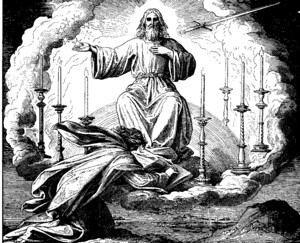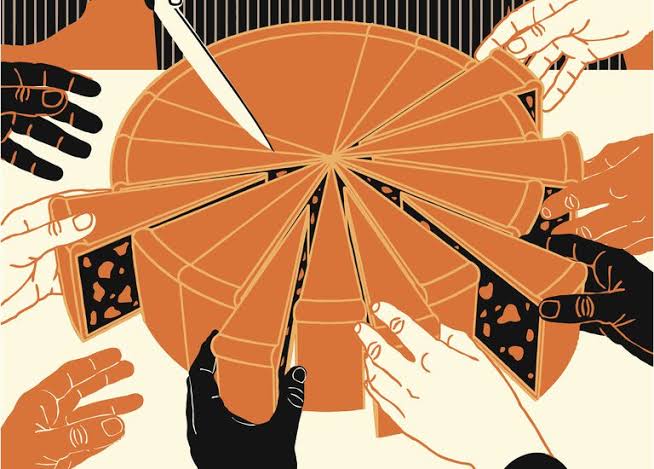“Bolshevism is not merely a political doctrine; it is also a religion, with elaborate dogmas and inspired scriptures. When Lenin wishes to prove some proposition, he does so, if possible, by quoting texts from Marx and Engels.” – Bertrand Russell[1]
One of the main beliefs of progressives and liberals is that humanity can be somehow transformed into a species in which there is no inequality or discrimination. Progressivism and liberalism have their origins in the European enlightenment.[2] At the same time, millenarianism is a 2000-year old tendency in Christianity present since its inception that believes in an imminent end of the world and the second coming of a messiah. As the philosopher John Gray has shown in his various books, including Black Mass[3], the enlightenment often adopted certain aspects of Abrahamic monotheism like millenarianism – minus God – eventually giving rise to modern, progressive thought.
sarva-bhutāni kaunteya
prakrtim yānti māmikam |
kalpa-ksaye punas tāni
kalpādau visrjāmy aham ||9.7||
“O son of Kunti, all the beings go back at the end of a kalpa (cycle) to my prakrti (primordial energy). I project them forth again at the beginning of another kalpa.” – Bhagavan Sri Krishna in the Bhagavad Gita
Dharmic religions like Hinduism, Jainism and Buddhism take a cyclical view of time wherein the current yuga (age) is seen as part of a cycle of yugas which is collectively known as samsara. Similar views were held by ancient pagan Greeks and Romans. On the other hand, monotheist religions, including Islam and Christianity, view time as a linear progression in which history moves through a few fixed stages. The medieval theologian, Joachim of Fiore, described the three stages as follows [4]:
- The Age of the Father: corresponding to age of the Old Testament
- The Age of the Son: corresponding to the age of the New Testament after the coming of Jesus
- The Age of the Spirit: corresponding to complete spiritual freedom for the believers after the Final Judgement

This threefold division of linear time is found elsewhere too. In Islam, the stages of history include Jahiliyyah[5] (stage of ignorance), followed by the arrival of the prophet, finally ending in Qiyāmah or Qayāmat (the coming of the Mahdi[6] – the Guided One– followed by the day of judgement). In the view of the 19th century founder of positivism, Auguste Comte, the three stages of society included the age of theology, the age of metaphysics and the final age of science. Comte characterized his positivist philosophy as the “Religion of Humanity”. Marx also described history in terms of primitive society, class society and the future classless, stateless communism. The phrase, “Third Reich”, used to describe the Nazi period in Germany also harks back to the Abrahamic threefold division of time as formulated by Joachim of Fiore. [7]
The end of history
Christianity originated in a few heterodox Jewish sects, which prophesied the coming of a final messiah to deliver the judgement to save only the believers and destroy all the non-believers. The teaching of Jesus was originally targeted towards other Jews to whom Jesus proclaimed the coming of a new kingdom of unlimited abundance with himself as its King. However, this kingdom never materialised as the Romans arrested and crucified him. His early followers were left devastated. But they consoled themselves by imagining that he somehow rose from the dead, went to heaven and promised to return some day to destroy all evil. The medieval Christian church at some point tried to project the view that this final coming of Jesus and the destruction of evil should not be taken literally and adopted this as the official church doctrine. However, this did not prevent several millenarian movements from popping up every now and then.

In medieval Germany, the immiseration of the peasants resulted in several rebellions. These peasants perhaps found some comfort in the millenarian view that the end times are near, and that the final messiah will be arriving any day. Thomas Müntzer was a radical preacher and theologian who was one of the leaders of these peasant rebellions. Writing in later times, Marxists such as Friedrich Engels and Karl Kautsky claimed him as a precursor of the revolutionaries of more modern times. With the inspiration of preachers such as Müntzer, one of the most barbaric experiments in early communism was carried out by a sect of radical anabaptists in the form of the Münster Rebellion of 1534-35. [8] These radical anabaptists literally believed that the day of the final judgement would arrive on a particular day in 1534 and began to migrate en masse to Münster and eventually formed a majority of the city population. In preparation of the day of judgement, the radicals took control of the city and broke all the icons in the cathedrals and monasteries. All books other than the Bible were burned. Everyone was forced to convert to the new radical sect or be killed. The property of those who emigrated was shared with the poor and soon a decree was issued to hold all property in common. Their leader, John of Leiden, made polygamy compulsory and himself took sixteen wives. Many women who refused such marriages were put to death. Meanwhile, the former bishop of Münster put the city under siege which lasted for nearly a year, forcing the residents of the city into starvation. The siege ended with the retaking of the city and the execution of all the radical leaders.
Norman Cohn, in 1957, described five characteristics of salvation as seen by all millenarian movements.[9] The millenarian salvation is:
- Collective: enjoyed exclusively by the community of the faithful
- Terrestrial: happens on this earth
- Imminent: takes place any time soon
- Total: completely transforms all life to absolute perfection
- Miraculous: accomplished with the help of divine intervention
Many modern ideologies such as progressivism, communism and Nazism display the above millenarian characteristics. Liberals and progressives, such as the Nehruvians, believe that humanity is moving towards or must be made to move towards a perfect state of existence. One of the ways this perfection could be achieved is by enacting various laws to bring about social justice. The Jacobins of the French Revolution were the first ones to use mass terror to enforce the enlightenment ideals on human society. Communists such as Marx, Lenin, Stalin etc. were inspired by the enlightenment and advocated for violent revolution to bring about a prophesied end of history in the form of a worldwide classless, stateless utopia. Nazism also arose as a violent millenarian movement inspired by the scientific racism that was popular in most of the Western countries during the enlightenment. As Gray shows, modern radical Islamic terrorism was also made possible because the modern Islamist ideologues adopted some of the enlightenment tools and strategies. [10]
Progressivism and radical Islam
Interestingly, today’s left liberals and progressives can be seen flirting with radical Islam all over the world.[11] Also, modern Islamist ideologues like Ali Shariati, early leader of the Iranian revolution, and Sayyid Qutb, leading member of the Egyptian Muslim Brotherhood, were inspired by the red terror unleashed by Lenin. Looking back in recent history, Marxists and radical Islamists have often found themselves working together to achieve certain common goals. However, these partnerships have also ended with one side butchering the other. Following the Bolshevik revolution of 1917, Lenin promised liberation for the Muslims of the former Russian empire and appointed the Muslim Tatar, Mirsaid Sultan-Galiev, to oversee the affairs of the Muslims of the Caucasus and Central Asia. The Bolsheviks even called upon them to wage a “holy war” against Western imperialism. [12] However, tragically, under the later leadership of Stalin, the attitude towards religion and non-Marxist culture was hardened and Galiev was purged. Mass population transfer was carried out resulting in the deaths of millions in places such as the Caucasian Republics.[13]


In Iran, the communists helped in deposing the Shah and bringing about the formation of an Islamic theocratic republic in 1979 and even stood behind all the fundamentalist Islamic laws that were being enacted. Nevertheless, in the timespan of a few years, most of the communist leaders were killed or jailed under suspicion of being Soviet spies and the communist party was banned.[14] In Afghanistan, Soviet-backed communists based out of the urban, educated elite ruled the country for over ten years following a military coup in 1979. However, large sections of the Islamic population mostly viewed the atheistic communist rulers with contempt. Following a bloody 12-year war, US and Pakistan-backed radical Islamists overthrew the government in 1992 and massacred the communists.[15]
Terror and the Enlightenment

As has been seen thus far, radical manias can sometimes grip entire populations on a large scale leading to very unpleasant results. Gray has shown how certain traumatic incidents can cause entire populations to begin hankering for certain forms of millenarianism.[16] The rise of Bolshevism and Nazism were among the catastrophic consequences of the First World War. The Bolshevik tendency of violently suppressing dissent was started by Lenin, who gave orders for several repressions, including the Trotsky-led storming of the Kronstadt fortress, held by rebellious Soviet sailors, leading to more than 10,000 casualties.[17] Among the victims of communist regimes are millions of workers, peasants and many communists themselves. In any case, both Stalin and Mao believed in transforming society to achieve the highest scientific ideal in accordance with the western enlightenment view. For this, they set to bring about a fundamental change in the way humans behaved. Thus, most western intellectuals cheered – in anticipation of an enlightenment-inspired utopia – when Stalin carried out his mass executions and famines, and when Mao brought about the greatest human catastrophe in history in the form of the Great Leap Forward, and then declared war on all ancient Chinese culture during the Cultural Revolution. It was only when it became clear that no utopia was achieved, and tens of millions of people died for nothing that Stalin and Mao began to lose support among the intelligentsia. [18]
Antisemitism was born in the early days of Christianity. The belief that the Jews were somehow demonic and had to be eradicated was prevalent in all the Protestant and millenarian movements in the middle ages.[19] The racism of the late 19th century enlightenment sanctified genocide as being scientific and necessary for civilisation. Nazism got its inspiration from those enlightenment thinkers who were opposed to liberal values. A belief that the white Europeans were the superior race was common in the enlightenment thinkers, including Marx, who supported British colonialism in India as a means of overcoming Oriental Despotism which was supposed to have been propped up by the “sluggish Indian village life”. James Mill, John Stuart Mill and other enlightenment thinkers also supported the British colonisation of India. Similarly, John Locke defended the capture of lands from the Native Americans. Nearly all enlightenment thinkers held the view that all Africans and Asians had to be forcibly turned into Europeans by any means necessary to achieve progress. [20]
Hitler admired the American genocidal treatment of the indigenous peoples, who were subjected to horrible suffering in the form of starvation, sterilization and reeducation. The Nazis wanted to achieve a Darwinian social order in which the “superior races” ruled over others so that a form of human perfection could be achieved with the use of eugenics and human experimentation. Jews, Slavs and Gypsies (or Roma) – migrants from India following the Islamic invasions – were among the victims of the Nazi racial genocide. Nazis thus drew from the historical Christian hatred of the Jew and combined it with modern racist ideology. Jews were portrayed as embodying all evil and their extermination was portrayed as a means to eliminate evil from this world. Hitler was a modern version of John of Leiden, fighting for the salvation of the Nordic races.[21]
Conclusion: Is progress a lie?

The progressives of today, including the Nehruvians, believe that the world can be transformed such that there can be perfect equality and abundance for all.[23] This is often a convenient myth used to justify various social engineering schemes to remake the human nature. Also, both the Abrahamic monotheists and the progressive left have a certain form of demonology[24] built into them. This demonology makes them blame evil forces (instead of normal human failings) whenever reality fails to satisfy their unworkable, utopian dreams. They see themselves as being called to struggle against these evil forces. For example, this manifests itself whenever they claim to be victims of persecutions. [25] Hinduism, Brahmins, the Vedas etc. are often portrayed by the progressive left as the ultimate evil that stand in the path of this utopian world.[26]
There is much evidence to show that the so-called modern world is not inexorably headed towards progress and higher ethics. Throughout history, many civilisations have risen and fallen. Various factors including war, disease, famine, climate change, demography etc. have had major impacts on whether civilisations survive or die. It can be also be seen that civilisations like Assyria, Egypt, Rome etc. could achieve a high standard of technology and living standards at a certain stage before being extinguished. Progress in science and technology does not equate to civilisational or ethical progress.
Another example is the state of Pakistan. In pre-partition times, in what is today Pakistan, although the Hindus were in a minority, many ancient living temples could be found, and some vestiges of the Sanatana religion and culture prevailed in some pockets, providing some diversity. However, in the last 70 years, with the imposition of the monochromatic uniformity of radical Islam, diversity has practically been wiped out. Also, all outlets for human creativity in the form of art, aesthetics, literature, music, films etc. are dying out. The region known as Pakistan has experienced a civilisational collapse with little hope of recovery any time soon.[27]
In talking of bringing about a change in human nature, it is interesting to note that in the Arthashastra of 3rd century B.C.E., Kautilya advocates imposing fines on those who speak abusively[28], thus enforcing polite speech by law. It has been more than 2200 years since the Arthashastra was written. In Indian society, being respectful to each other, especially to the elders, and avoiding foul language in most conversation has been traditionally held in high regard. It is important to note that this kind of civilised behaviour comes about only when a certain level of sophistication has been achieved by a society. In practical terms, because all members of society received the right samskaras[29] (refinement of mind), this level of sophistication was brought about in Indian society over the course of thousands of years.
“Calumny, contemptuous talk, or intimidation constitutes defamation. Among abusive expressions relating to the body, habits, learning, occupation, or nationalities, that of calling a deformed man by his right name such as ‘the blind’, ‘the lame’, etc. shall be punished with a fine of 3 panas”
– Arthashastra. Book 3. Chapter 18
As part of the Hindu cosmology, ancient Indians conceived of a cyclical view of time and the possibility of existence of multiple worlds, as did the ancient Greeks and Romans. Although for a long time, monotheistic dogma had enforced the view of a fixed, linear time, modern physics today theorises about cosmological models of multiple universes which in turn follow infinite, or indefinite, self-sustaining cycles with scales of billions of years.[30]
In terms of utopian ideals, the idea that a Rama Rajya
should come about one day is a deeply engrained concept among many Indians. This
idea was also promoted by Mahatma Gandhi.[31]
The concept originates in the Ramayana, which describes Ayodhya, led by
Lord Rama, to be a kingdom that exhibited near perfection in the art of good
governance as it followed the principles of dharma. It should be noted
that pluralism and nuance are quite innate to Dharmic thought. For example, Hinduism
lacks any creed that everyone is required to believe and there are no “chosen
or saved people” like the Ummah in Islam or the Christendom in
Christianity or the Proletariat in Marxism. A Rama Rajya or a Dharmocracy[32]
can be described as governance based on the timeless principles of dharma
which entails pluralism and eco-friendliness. Although this is a utopian ideal
to which the Indian state can aspire towards, it is not achieved by millenarian,
exclusionary means.
[1] Russell, Bertrand. The Practice and Theory of Bolshevism (1920)
[3] Gray, John. Black Mass. (2007)
[4] Gray, John. Black Mass. (2007)
[5] Initially Jahilliya was used to refer to pre-Islamic Arabia. This term has been used by radical Islamists to refer to any non-Islamic country
[6] The belief in the coming of the Mahdi has been exploited by radical Islamists, including Osama Bin Laden.
[7] Gray, John. Black Mass. (2007)
[8] “The gruesome story of a radical ISIS-like movement that once ruled Münster”
[9] Cohn, Norman. The Pursuit of the Millennium. (1957)
[10] Gray, John. Black Mass. (2007)
[11] For instance, supporting convicted terrorists such as Mohammed Afzal: “JNU orders probe into Afzal Guru event”
[12] “What Killed the Promise of Muslim Communism?”
[13] “Population transfer in the Soviet Union”
[14] “Lessons from the Tudeh Party for the Middle East”
[15] “Democratic Republic of Afghanistan”
[16] Gray, John. Black Mass. (2007)
[18] Gray, John. Black Mass. (2007)
[19] This can be compared to how Brahmins are portrayed as the ultimate evil in the progressive and Islamist discourse in today’s India
[20] Gray, John. Black Mass. (2007)
[21] Gray, John. Black Mass. (2007)
[22] “JNU students write “Brahmin, quit India” during protest”
[23] “Human Progress Is a Lie”
[25] Gray, John. Black Mass. (2007)
[26] “Brahmin | Scroll.in”, “Shall we kill the Brahmins?”
[27] “Cultural casualty: Pakistan’s plunge towards Al-Bakistan”
[28] Shamashastry, R. Kautilya’s Arthashastra.
[30] “Cyclic model”, “Multiverse”. Note that although it is possible that a nuclear or ecological catastrophe could wipe out the human species at some point in the future, the earth and the universe are likely to continue to exist. The possibility of an end of history for the entire universe seems unlikely.
[31] Dhiman, Santinder. Gandhi and Leadership (2016), “Ramrajya”
Featured Image: ThoughtCo

